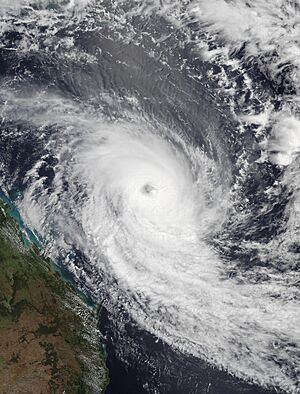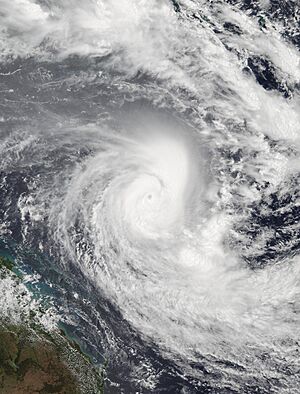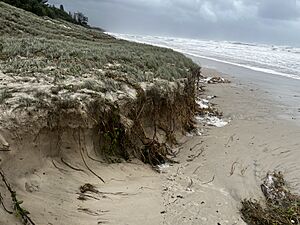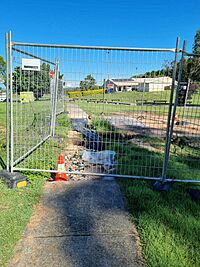Cyclone Alfred facts for kids

Cyclone Alfred at its secondary peak intensity on 28 February 2025
|
|
| Meteorological history | |
|---|---|
| Formed | 21 February 2025 |
| Dissipated | 9 March 2025 |
| Category 4 severe tropical cyclone | |
| 10-minute sustained (BOM) | |
| Highest winds | 165 km/h (105 mph) |
| Lowest pressure | 951 hPa (mbar); 28.08 inHg |
| Category 4 tropical cyclone | |
| 1-minute sustained (SSHWS/JTWC) | |
| Highest winds | 215 km/h (130 mph) |
| Lowest pressure | 943 hPa (mbar); 27.85 inHg |
| Overall effects | |
| Fatalities | 1 |
| Injuries | 39 |
| Missing | 4 |
| Damage | >$1.18 billion (2025 USD) |
| Areas affected | Willis Island, South East Queensland, New South Wales North Coast |
|
Part of the 2024–25 Australian region cyclone season |
|
Severe Tropical Cyclone Alfred was a strong and long-lasting tropical cyclone that caused major problems in South East Queensland and the New South Wales North Coast in early 2025. It was the seventh storm to be named during the 2024–25 Australian region cyclone season.
Many people expected Cyclone Alfred to be one of the biggest weather events in Australia's recent history. Because of this, warnings were sent out and people were evacuated in areas that don't usually get hit by cyclones.
Even though the cyclone weakened before it reached the coast on March 8, its heavy rain caused serious flooding. The storm led to at least one death, with four other people reported missing. The total damage was estimated to be over US$1.18 billion.
Contents
How the Cyclone Formed and Moved
The story of Cyclone Alfred began on February 20, 2025. Weather experts noticed a developing storm system in the Coral Sea, near Papua New Guinea. The conditions were perfect for a cyclone to form, with warm ocean water and the right kind of wind.
The system grew stronger as it moved southeast. On February 22, Australia's Bureau of Meteorology (BoM) officially named it Tropical Cyclone Alfred. At this point, it was a category 1 storm on the Australian scale.
Over the next few days, Alfred continued to move east and gain power.
- February 24: Upgraded to a category 2 tropical cyclone.
- February 26: Became a category 3 "severe" tropical cyclone.
- February 27: Reached category 4 strength, with a small eye (the calm center of the storm) visible on satellite images.
The cyclone's strength changed a lot over the next week. It weakened and then got stronger again as it moved slowly off the coast. On March 7, Alfred finally made landfall on Moreton Island as a category 1 cyclone. The next day, it was downgraded to a tropical low after it moved over the mainland.
Scientists noted that it was unusual for a cyclone to hit this part of southern Queensland and northern New South Wales. They believe that climate change may be causing powerful storms like Alfred to happen more often in areas outside the tropics.
Getting Ready for the Storm
As Cyclone Alfred got closer to the coast, communities in Queensland and New South Wales prepared for its arrival.
Warnings and Evacuations
On March 3, the BoM issued a cyclone watch for the coast from Sandy Cape in Queensland to Grafton in New South Wales. This included major cities like Brisbane and the Gold Coast. The next day, this was upgraded to a cyclone warning, the first one for Brisbane since 1990.
Local councils opened stations where people could get sandbags to protect their homes from flooding. In Noosa and on the Sunshine Coast, thousands of sandbags were given out. Evacuation centers were also opened in Noosa and the Northern Rivers region for people who needed a safe place to stay.
Closures and Cancellations
To keep people safe, many places were closed and events were cancelled.
- Schools: All schools in the affected areas of Queensland and New South Wales were closed. Universities also shut down their campuses.
- Transport: Brisbane Airport and Gold Coast Airport stopped all flights. CityCat and ferry services in Brisbane were also suspended.
- Events: Major sporting events, like two AFL matches and a NRL game, were postponed or moved. A Green Day concert on the Gold Coast was also cancelled.
The Australian Government activated the Australian Defence Force (ADF) to help with the emergency. The ADF helped deliver hundreds of thousands of sandbags and had heavy-lift helicopters ready to assist.
The Impact of Cyclone Alfred
Even before the cyclone made landfall, its effects were being felt. Huge waves caused coastal erosion, washing away large amounts of sand from beaches along the coast.
Damage and Power Outages
On March 7, strong wind gusts over 100 km/h were recorded on the Gold Coast. The powerful winds knocked down large trees and power lines. At the peak of the storm, over 300,000 homes and businesses in Queensland and New South Wales lost electricity.
The heavy rain led to severe flooding. Sadly, a man died in Dorrigo, New South Wales, when his car was swept away by floodwaters. In another incident, a collision between two ADF vehicles in Lismore, New South Wales, left 36 people injured.
On the Gold Coast, the roof of an apartment building was torn off, injuring one woman. In Brisbane, the storm overwhelmed the sewer system, forcing officials to release raw sewage into the Brisbane River.
The Aftermath
After the storm passed, communities began the long process of cleaning up. The damage to the beaches was severe, with an estimated six million cubic meters of sand eroded from the Gold Coast alone. City officials worked hard to repair the beaches in time for the Easter holidays to help the tourism industry.
Political Response to the Cyclone
| Costliest Australian region tropical cyclones | |||
|---|---|---|---|
| Rank | Tropical cyclones | Season | Damage |
| 1 | 4 Yasi | 2010–11 | $3.6 billion |
| 2 | 4 Debbie | 2016–17 | $2.73 billion |
| 3 | TS Oswald | 2012–13 | $2.52 billion |
| 4 | 4 Veronica | 2018–19 | $1.2 billion |
| 5 | 5 Ita | 2013–14 | $1.15 billion |
| 6 | 4 Larry | 2005–06 | $1.1 billion |
| 7 | 4 Alfred | 2024–25 | $820 million |
| 8 | 4 Zelia | 2024–25 | $733 million |
| 9 | 4 Jasper | 2023–24 | $670 million |
| 10 | 3 Tracy | 1974–75 | $645 million |
During the crisis, the actions of some political leaders were questioned. The Leader of the Opposition, Peter Dutton, and the Gold Coast Mayor, Tom Tate, were criticized for being away from their communities during the storm.
Mr. Dutton was in Sydney for a fundraising event, while Mayor Tate was in Las Vegas for a rugby league game. Both leaders explained their situations, but some people felt they should have been home during the emergency.
Prime Minister Anthony Albanese also attended a fundraiser in Sydney on the same day as Mr. Dutton. However, the Prime Minister's electorate is in Sydney, which was not in the cyclone's path. The cyclone also influenced the timing of the federal election, as the Prime Minister decided to delay calling it to focus on the storm recovery efforts.
See also
- List of storms named Alfred
- Tropical cyclones in 2025
- Weather of 2025
- Cyclone Jasper (2023) – another storm which significantly weakened before reaching the Queensland coast.
Images for kids






